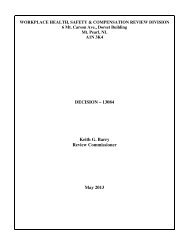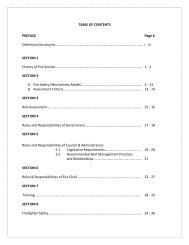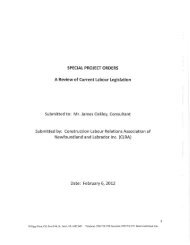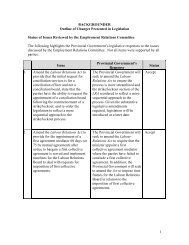Basic Level Pre-Course Reading
Basic Level Pre-Course Reading
Basic Level Pre-Course Reading
Create successful ePaper yourself
Turn your PDF publications into a flip-book with our unique Google optimized e-Paper software.
Chapter 5<br />
Control the Situation<br />
5.3.4 Decontamination<br />
It is important for responders at the <strong>Basic</strong> level to understand decontamination<br />
because it is an essential component in resolving a CBRN terrorist incident.<br />
decontamination is a Key Response Task implemented to “control the hazard”. It<br />
has a preventative value and contributes significantly to the successful mitigation<br />
of the consequences of a CBRN terrorist incident when conducted properly.<br />
While decontamination is usually conducted by responders with Intermediate<br />
level training (a core skill of the HAZMAT component of the response), other<br />
responders may be required to assist in the process. At a minimum, all on-scene<br />
responders should recognize the decontamination set-up and understand its role.<br />
The purpose of the decontamination process is to remove or neutralize<br />
contaminants from casualties, responders, equipment, and evidence. It is a<br />
planned, systematic, thorough, technical, and staged process for maximum<br />
removal of contamination. The process also includes precautionary measures<br />
intended to limit cross-contamination. The term “clean” is used to indicate that<br />
something, which may have been contaminated, has been passed through this<br />
process.<br />
Decontamination requires the training, skill, and equipment associated with<br />
Intermediate level training. It includes a requirement for agent detection, the<br />
selection of decontaminating solutions based on agent identification, and<br />
alternative levels of PPE. This labour intensive process requires time to set up<br />
and staff to sustain over a long-term operation. It is a comprehensive step-bystep<br />
process and thus is limited by the rate at which it can be conducted.<br />
Consequently, there is limited capacity for dealing with volumes of people. This<br />
process, however, must not be rushed to the point that the efficiency of agent<br />
elimination is compromised.<br />
5.3.5 Key Components of the Decontamination Process<br />
Equipment requirements – the Decontamination process requires high levels of<br />
personal protection, detection equipment, shelters, specific decontaminants, and<br />
shower systems.<br />
Location – this process is always established within the Warm Zone. There is a<br />
clear entry point from the direction of the Hot Zone and a clear exit point toward<br />
the Cold Zone. Early decontamination measures are often implemented at the<br />
exit point from the Hot Zone to reduce the spread of contamination as soon as<br />
possible.<br />
The decontamination process is designed to reduce the threat posed by<br />
contamination in a graduated manner. This becomes increasingly complex when<br />
casualties require decontamination and are unconscious or otherwise nonambulatory.<br />
CBRN First Responder Training Program<br />
50<br />
<strong>Basic</strong> <strong>Level</strong> <strong>Course</strong>

















